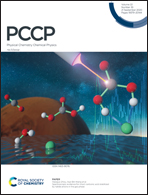Theoretical study on the absorption of carbon dioxide by DBU-based ionic liquids†
Abstract
In this article, 20 ns molecular dynamic (MD) simulations and density functional theory (DFT) were used to investigate the absorption of CO2 molecules by some functionalized 1,8-diazabicyclo[5,4,0]-udec-7-ene (DBU)-based ILs. According to the MD results, the highest coordination number for N⋯C is observed in the case of [DBUH+][Im−], which indicates that the functionalization of the imidazole anion by different alkyl groups decreases the interaction ability of the anion with CO2 molecules. The addition of water molecules to the ILs decreases the ability of the anion to interact with CO2 because of the hydrogen bond formation between the imidazole anions and water. Two different paths were proposed for CO2 absorption by the ILs, and the effect of alkyl groups on the kinetics and thermodynamics of the reaction was analyzed by using the M06-2X functional at the 6-311++G(d,p) level of theory in the gas phase and water. On the basis of the results, CO2 absorption is more favorable in [DBUH+][Im−], thermodynamically. Kinetic parameters show that the alkylation of the imidazole anion by ethyl, propyl, iso-propyl, and phenyl groups decreases the rate of CO2 absorption, because of the steric and electron-withdrawing effect of different alkyl groups. In the presence of water molecules, the lowest activation Gibbs energy is related to [DBUH+][Im−], which confirms the greater ability of this IL in CO2 absorption.



 Please wait while we load your content...
Please wait while we load your content...